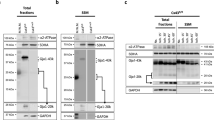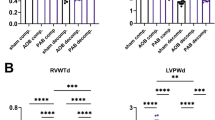Abstract
Myocardial adaptation to ischemia involves up-regulated expression of a number of genes implicated in conferring cytoprotection. We have previously shown that myocardial ischemia followed by reperfusion leads to a co-ordinated expression of mRNAs encoding heme oxygenase-1 (HO-1) and ubiquitin in pigs. HO-1 participates in biological reaction leading to the formation of the antioxidant, bilirubin and the putative cellular messenger, carbon monoxide. In the present study, we examined the expression and cellular localization of HO-1 in the heart during myocardial stunning in anesthetized pigs. After thoracotomy, the LAD was occluded for 10 min and reperfused for 30 min (group I, n = 4), again occluded for 10 min and reperfused for 30 min (group II, n = 6), 90 min (group III, n = 4), 210 min (group IV, n = 5) and for 390 min (group V, n = 4). Myocardial tissue specimens were collected in 10% formalin as well as in liquid nitrogen and processed for immunohistochemistry and mRNA expression analysis, respectively. In the distribution territory of the LAD (experimental, E), systolic wall thickening was significantly decreased (39 ± 6%) as compared to that of the area perfused by left circumflex coronary artery (LCx, control) in group I and remained depressed in all subsequent groups. Northern blot analysis revealed that the expression of a single mRNA species of 1.8 kb encoding HO-1 was significantly induced in E as compared to control in groups II and III with maximum mRNA levels in group II (1.9 ± 0.4 fold vs. control). Immunoreactive HO-1 was localized in the cytoplasm of cardiomyocytes as well as in the perivascular regions in all groups. Semiquantitative analysis of HO-1 staining showed significantly enhanced levels of HO-1 in perivascular region in E as compared to respective controls derived from groups III and IV. These results suggest that myocardial adaptive response to ischemia involves up-regulation of HO-1 in cells of perivascular region indicating that this enzyme may participate in regulating vascular tone via CO and thereby, contributing in pathophysiologically important defense mechanism(s) in the heart.
Similar content being viewed by others
References
Maines MD: The heme oxygenase system: a regulator of second messenger gases. Ann Rev Pharmacol Toxicol (review) 37: 517–554, 1997
Choi AM, Alam J: Heme oxygenase-1: Function, regulation, and implication of a novel stress-inducible protein in oxidant-induced lung injury. Am J Resp Cell Mol Biol (review) 15: 9–19, 1996
Prabhakar NR, Dinerman JL, Agani FH, Snyder SH: Carbon monoxide: A role in carotid body chemoreception. Proc Natl Acad Sci (USA) 92: 1994–1997, 1995
Cruse I, Maines MD: Evidence suggesting that the two forms of heme oxygenase are products of different genes. J Biol Chem 263: 3348–3353, 1988
Shibahara S, Yoshizawa M, Suzuki H, Takeda K, Meguro K, Endo K: Functional analysis of cDNAs for two types of human heme oxygenase and evidence for their separate regulation. J Biochem 113: 214–218, 1993
Raju VS, Maines MD: Coordinated expression and mechanism of induction of HSP32 (heme oxygenase-1) mRNA by hyperthermia in rat organs. Biochim et Biophys Acta 1217: 273–280, 1994
Sharma HS, Maulik N, Gho BC, Das DK, Verdouw PD: Coordinated expression of heme oxygenase-1 and ubiquitin in the porcine heart subjected to ischemia and reperfusion. Mol Cell Biochem 157: 111–116, 1996
Keyse SM, Applegate LA, Tromvoukis Y, Tyrrell RM: Oxidant stress leads to transcriptional activation of the human heme oxygenase gene in cultured skin fibroblasts. Mol Cell Biol 10: 4967–4969, 1990
Ewing JF, Maines MD: Rapid induction of heme oxygenase 1 mRNA and protein by hyperthermia in rat brain: Heme oxygenase 2 is not a heat shock protein. Proc Natl Acad Sci (USA) 88: 5364–5368, 1991
Shibahara S, Muller RM, Taguchi H: Transcriptional control of rat heme oxygenase by heat shock. J Biol Chem 262: 12889–12892, 1987
Ewing JF, Raju VS, Maines MD: Induction of heart heme oxygenase-1 (HSP32) by hyperthermia: Possible role in stress-mediated elevation of cyclic 3′:5′-guanosine monophosphate. J Pharmacol Exp Therap 271: 408–414, 1994
Vile GF, Basu MS, Waltner C, Tyrrell RM: Heme oxygenase 1 mediates an adaptive response to oxidative stress in human skin fibroblasts. Proc Natl Acad Sci (USA) 91: 2607–2610, 1994
Morita T, Perrella MA, Lee ME, Kourembanas S: Smooth muscle cell-derived carbon monoxide is a regulator of vascular cGMP. Proc Natl Acad Sci (USA) 92: 1475–1479, 1995
Wagner CT, Durante W, Christodoulides N, Hellums JD, Schafer AI: Hemodynamic forces induce the expression of heme oxygenase in cultured vascular smooth muscle cells. J Clin Invest 100: 589–596, 1997
Ishizaka N, de LH, Laursen JB, Fukui T, Wilcox JN, De KG, Griendling KK, Alexander RW: Angiotensin II-induced hypertension increases heme oxygenase-1 expression in rat aorta. Circulation 96: 1923–1929, 1997
Maulik N, Engelman DT, Watanabe M, Engelman RM, Rousou JA, Flack J III, Deaton DW, Gorbunov NV, Elsayed NM, Kagan VE, Das DK: Nitric oxide/carbon monoxide. iA molecular switch for myocardial preservation during ischemia. Circulation 94: II398–406, 1996
Poss KD, Tonegawa S: Reduced stress defence in heme oxygenase-1 deficient cell. Proc Natl Acad Sci (USA) 94: 10925–10930, 1997
Raju VS, Maines MD: Renal ischemia/reperfusion up-regulates heme oxygenase-1 (HSP32) expression and increases cGMP in rat heart. J Pharmacol Exp Ther 277: 1814–1822, 1996
Stevens CF, Wang Y: Reversal of long term potentiation by inhibitors of haem oxygenase. Nature (London) 364: 147–149, 1993
Lavrovsky Y, Schwartzman ML, Levere RD, Kappas A, Abraham NG: Identification of binding sites for transcription factors NF-kappa B and AP-2 in the promoter region of the human heme oxygenase 1 gene. Proc Natl Acad Sci (USA) 91: 5987–5991, 1994
Camhi SL, Alam J, Wiegand GW, Chin BY, Choi AM: Transcriptional activation of the HO-1 gene by lipopolysaccharide is mediated by 5′distal enhancers: Role of reactive oxygen intermediates and AP-1. Am J Resp Cell Mol Biol 18: 226–234, 1998
Murry C, Jennings R, Reimer K: Preconditioning with ischemia: A delay of lethal cell injury in ischemic myocardium. Circulation 74: 1124–1136, 1986
Schott R, Rohmann S, Braun E, Schaper W: Ischemic preconditioning reduces infarct size in swine myocardium. Circ Res 66: 1133–1142, 1990
Bolli R: Mechanisms of myocardial stunning. Circulation 82: 723–738, 1990
Sharma HS, Wünsch M, Brand T, Verdouw PD, Schaper W: Molecular biology of the coronary vascular and myocardial responses to ischemia. J Cardiovasc Pharmacol 20: S23–S31, 1992
Brand T, Sharma HS, Fleischmann KE, Duncker DJ, McFalls EO, Verdouw PD, Schaper W: Proto-oncogene expression in porcine myocardium subjected to ischemia and reperfusion. Circ Res 71: 1351–1360, 1992
Andres J, Sharma HS, Knoll R, Stahl J, Sassen LMA, Verdouw PD, Schaper W: Expression of heat shock proteins in the normal and stunned porcine myocardium. Cardiovasc Res 27: 1421–1429, 1993
Chomczynski P, Sacchi N: Single step method of RNA isolation by acid guanidinium thiocyanate-phenol-chloroform extraction. Anal Biochem 162: 156–159, 1987
Maulik N, Sharma HS, Das DK: Induction of heme oxygenase gene expression during the reperfusion of ischemic rat myocardium. J Mol Cell Cardiol 28: 1261–1270, 1996
Ito K, Ikeda S, Shibata T, Yano T, Horikawa S: Immunohistochemical analysis of heme oxygenase-1 in rat liver after ischemia. Biochem Mol Biol Int 43: 551–556, 1997
Giaid A, Michel RP, Stewart DJ, Sheppard M, Corrin B, Hamid Q: Expression of endothelin-1 in lungs of patients with cryptogenic fibrosing alveolitis. Lancet 341: 1550–1554, 1993
Tyrrell RM, Basu MS: Transient enhancement of heme oxygenase 1 mRNA accumulation: A marker of oxidative stress to eukaryotic cells. Meth Enzymol 234: 224–235, 1994
Katayose D, Isoyama S, Fujita H, Shibahara S: Separate regulation of heme oxygenase and heat shock protein 70 mRNA expression in the rat heart by hemodynamic stress. Biochem Biophys Res Comm 191: 587–594, 1993
Durante W, Kroll MH, Christodoulides N, Peyton KJ, Schafer AI: Nitric oxide induces heme oxygenase-1 gene expression and carbon monoxide production in vascular smooth muscle cells. Circ Res 80: 557–564, 1997
Lee PJ, Jiang BH, Chin BY, Iyer NV, Alam J, Semenza GL, Choi AM: Hypoxia-inducible factor-1 mediates transcriptional activation of the heme oxygenase-1 gene in response to hypoxia. J Biol Chem 272: 5375–5381, 1997
Kusuoka H, Marban E: Cellular mechanisms of myocardial stunning. Ann Rev Physiol 54: 243–256, 1992
Sharma HS, Das DK: Role of cytokines in myocardial ischemia and reperfusion. Mediat Inflam 6: 1–9, 1997
Sharma HS, Stahl J, Weisensee D, Löw-Friedrich I: Cytoprotective mechanisms in cardiomyocytes. Mol Cell Biochem 160/161: 217–224, 1996
Yellon D, Latchman D: Stress proteins and myocardial protection. J Mol Cell Cardiol 24: 113–124, 1992
Welch W: Mammalian stress response: Cell physiology, structure/ function of stress proteins, and implications for medicine and disease. Physiol Rev 72: 1063–1081, 1992
Sharma HS, Stahl J: Role of small heat shock proteins in the cardiovascular system. In: AA Knowlton (ed). Heat Shock Proteins and the Cardiovascular System. Kluwer Academic Publishers, Boston, USA, 1997, pp 127–158
Eyssen HR, Ladoux A, Frelin C: Differential regulation of cardiac heme oxygenase-1 and vascular endothelial growth factor mRNA expressions by hemin, heavy metals, heat shock and anoxia. FEBS Lett 382: 229–233, 1996
Deramaudt BM, Braunstein S, Remy P, Abraham NG: Gene transfer of human heme oxygenase into coronary endothelial cells potentially promotes angiogenesis. J Cell Biochem 68: 121–127, 1998
Author information
Authors and Affiliations
Rights and permissions
About this article
Cite this article
Sharma, H.S., Das, D.K. & Verdouw, P.D. Enhanced expression and localization of heme oxygenase-1 during recovery phase of porcine stunned myocardium. Mol Cell Biochem 196, 133–139 (1999). https://doi.org/10.1023/A:1006984027403
Issue Date:
DOI: https://doi.org/10.1023/A:1006984027403




